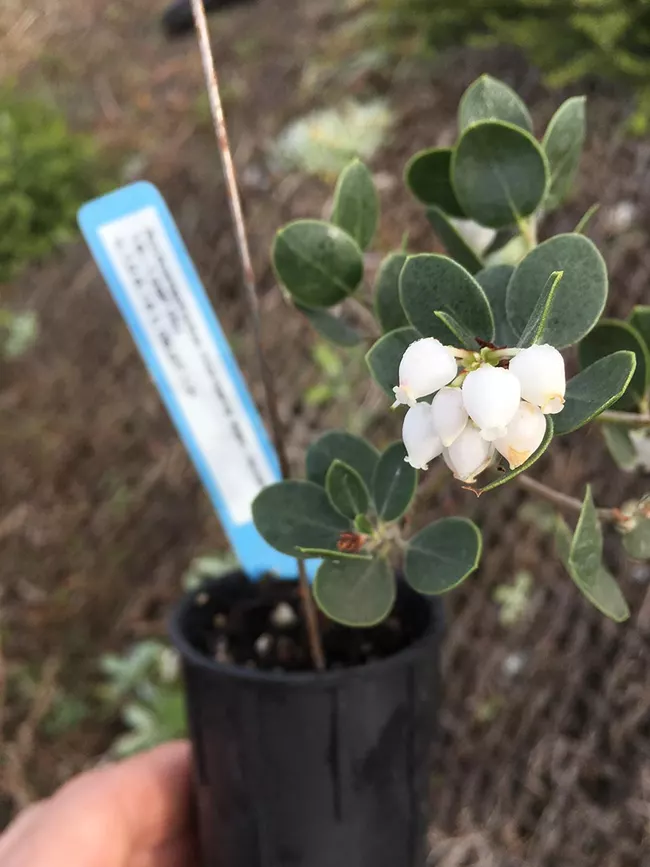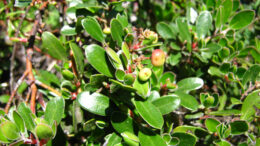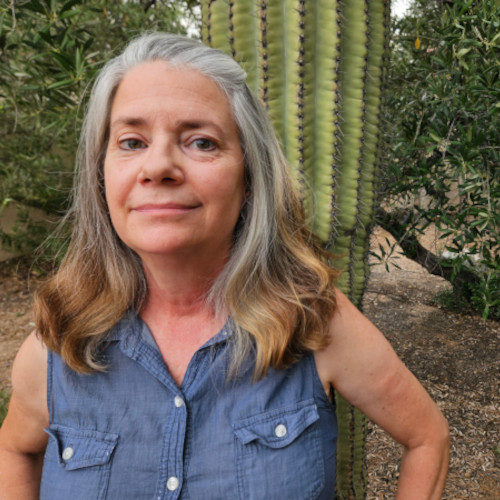Most visitors to San Francisco’s famed Presidio have no idea they’re strolling through the latest setting in a most implausible botanical story.
The star of the tale is a shrubby, red-limbed Franciscan manzanita, nicknamed Francie, and the fate of its kind may well rest on a combination of protection, the latest science, and the whims of reproduction.
But don’t go looking for Francie or its offspring just yet. The plant’s exact location remains a secret, its very existence fragile and its future not yet guaranteed.
In October 2009 a botanist driving along a busy San Francisco freeway spotted something growing in a traffic island surrounded by ramps near the Golden Gate Bridge. It was a “fairly ugly” bush, as Dan Gluesenkamp described it later, but he knew it was a manzanita — a genus of evergreen shrubs and small trees — and suspected it was the long-lost Franciscan manzanita, last seen more than 60 years earlier.
While California is home to 95 species and subspecies of manzanita, only two have been documented to live exclusively in the Bay Area. Both are exceedingly rare specialists adapted to that place’s soil configurations and fog. They are the Raven’s manzanita (Arctostaphylos montana ravenii) and the Franciscan manzanita (A. franciscana), named for the only city where it has ever grown in the wild and thought to have gone extinct in the wild in 1947.
Gluesenkamp was spot-on with his identification that day, and his timing couldn’t have been better: That section of Highway 101 was undergoing renovation. In fact, it was thanks in part to the project that Gluesenkamp could spot the bush at all. Before construction started, roadside trees had concealed the bush. Now those trees were being churned into wood chips, but a patrol car parked on the traffic island during the chipping operation spared the bush from being buried under the chip pile. For the first time in decades, the small island’s remaining vegetation had become visible from the road.
It was a little patch of serpentine substrate, caused by the state’s complicated geologic history. Serpentinite is California’s state rock, apple-green to black, often shiny and mottled with light and dark areas. Thanks to past earthquakes, San Francisco is laced with rocky outcrops of this unusual soil that stretch through the city. It’s rotten soil for most plants because it’s high in heavy metals, but manzanitas are adapted to it, thrive in it, and that’s where Franciscan manzanitas used to grow, on hills and ridges throughout San Francisco.
The traffic island had been disturbed just enough by earlier road crews that the single shrub was able to germinate and survive. But highway construction would soon doom its home to destruction. For this plant to survive, something had to be done — and fast.
Since they couldn’t build the new highway around the bush, the California Department of Transportation worked alongside conservationists to move it in 2010. Knowing that the last wild plant of its kind might not survive the ordeal, scientists took many precautions, including stem cuttings that could be rooted and cloned in a lab. The cuttings then went to six different institutions in the region, mostly botanical gardens. Scientists also took rooted branches that could be grown into separate shrubs. And the plant was in fruit, so they collected seeds and soil.
Then the last-known wild Franciscan manzanita was dug up and trucked about a mile away to a secret location in the Presidio, the old military post that had become part of Golden Gate National Park in 1994. The freeway-rescue was planted there and nicknamed “Francie.”
And the transplant was a success. Away from the freeway exhaust, the plant thrived. But could Francie reproduce?
Friends With Benefits
Michael Chassé is an ecologist with the National Park Service. He coordinates both the rare-plant monitoring program in the Golden Gate National Recreation Area and weekly volunteer programs that engage the community in habitat restoration. At the time Francie was found, he was working on a master’s thesis about San Francisco’s two endangered manzanitas. “The existing Franciscan manzanita is one genetic individual,” he says. “You can clone it. But if you have a second genetic individual, you’re expanding the genetic capacity for the individual. When you have cross-pollination, you have genetic recombination.”
Each unique genetic individual is what’s called a genotype. Bringing different genotypes together allows for greater diversity.
Francie was already producing seeds before she was relocated in 2010. Manzanitas have both male and female reproductive parts, but they still need to cross-pollinate to produce viable seeds.
“You want to avoid inbreeding depression,” explains Chassé. “Some naturally rare species have the ability to exist with a small number of individuals, but with ecological restoration you want to maximize their ability to adapt to change over time.”
While Francie may have been the last plant of its kind in the wild, it was not the sole surviving Franciscan manzanita. Turns out there were others, salvaged during the Great Depression from a San Francisco cemetery slated for destruction.
“We’re fortunate in that folks back in the 1930s saw that habitat for these rare manzanitas was being lost pretty rapidly,” Chassé says.
Thanks to prescient botanists nearly a century ago, those salvaged plants still live in Bay Area botanical gardens. What’s more, they’re genetically distinct, meaning they can cross-pollinate with Francie. Park staff planted cuttings from the cemetery survivors nearby, hoping that in time cross-pollination would occur.
Franciscan Manzanita cuttings are taking root at the Presidio Nursery in hopes of growing our rare plant populations. pic.twitter.com/5sIDzSdrrJ
— Golden Gate NPS (@GoldenGateNPS) March 7, 2017
Genetic diversity is Chassé’s biggest concern for the survival of these endangered plants. “We face an uncertain climate future, so we need to maximize genetic diversity to adapt to changes over time. That’s true for a common plant like yarrow and true for a rare plant like the Franciscan manzanita.”
The Presidio is working with California State University East Bay, looking at the genetics of the Franciscan manzanita to determine how many distinct individuals there are in the world.
“It’s a small number. We think there are maybe four,” Chassé says.
So far, despite flowering and occasional fruits, staff have seen no reproduction, according to Lew Stringer, associate director of landscape stewardship at Presidio Trust. Along with Chassé, Stringer helped identify Francie in its original location. If Francie can’t reproduce, is there a different scenario that might constitute recovery?
Perhaps, Stringer says. In attempting to recover certain endangered plants, scientists may be shifting away from a focus on pure gene strains and shifting toward “gene flow,” allowing different but closely-related species — some nearly lost, some not — to cross and thus create new strains of manzanitas able to survive over time.
Enter a second endangered manzanita, even more hard-up than the last.
What Constitutes Survival?
The Raven’s manzanita is named after Peter Raven, who made botanical history at age 13 when he rediscovered the species. That was in 1952; not another living specimen of its kind has been seen since. Many a last-of-its-kind has perished over the past century, so the recovery plan for the Raven’s manzanita is still more challenging than the one for its kin.
The end goal here, Stringer says, is gene flow. For the Raven’s manzanita to carry on, scientists will intentionally cross its genes with those of its closest relative (not the Franciscan, although Raven’s has the potential to cross with that and other manzanitas). Next they’ll analyze the genes of those offspring and determine which crosses align best with Raven’s.

At this point in time, the genetic prospects for the Franciscan manzanita probably look brighter. But even if Francie manages to produce viable offspring, there remains the same challenge faced by so many recovering species: vanishing habitat.
Both manzanitas once cascaded down hillsides, growing out of rocky outcrops and ridges of serpentine substrate that stretch through the city. But in San Francisco, habitat is also real estate, and much of that land is now covered in buildings. Parks are the closest thing left to the wild, so that’s where Chassé and other staff are focusing their efforts, clearing out invasive plants to restore what habitat remains. So far they’ve placed more than 150 Franciscan manzanita plantings in six sites, all within the Presidio.
It’s a small world. But in the case of the Franciscan manzanita, it was a small world to begin with. The plant’s natural habitat probably never extended far beyond San Francisco. Compare this to bison, a species that once roamed most of the continental United States. Which recovery has further to go?
Some might argue that a plant that only lives within the confines of one park isn’t living in the wild. Yet Chassé, who leads efforts to recover both species, cites our love of national parks as one of the challenges to doing that. While the location of both plants is undisclosed, San Francisco is a very popular tourist destination, he says, and “the habitats are pretty sensitive. Keeping people on trails, making sure they’re not trampling rare plants like these, is a concern.”
Previously in The Revelator:
Rock and Roll Botany: An Endangered Plant Named After Legendary Guitarist Jimi Hendrix



